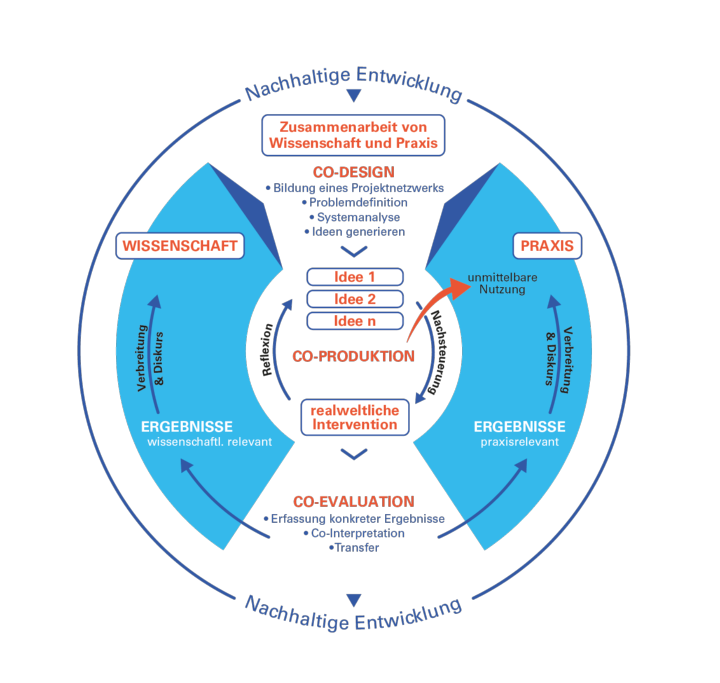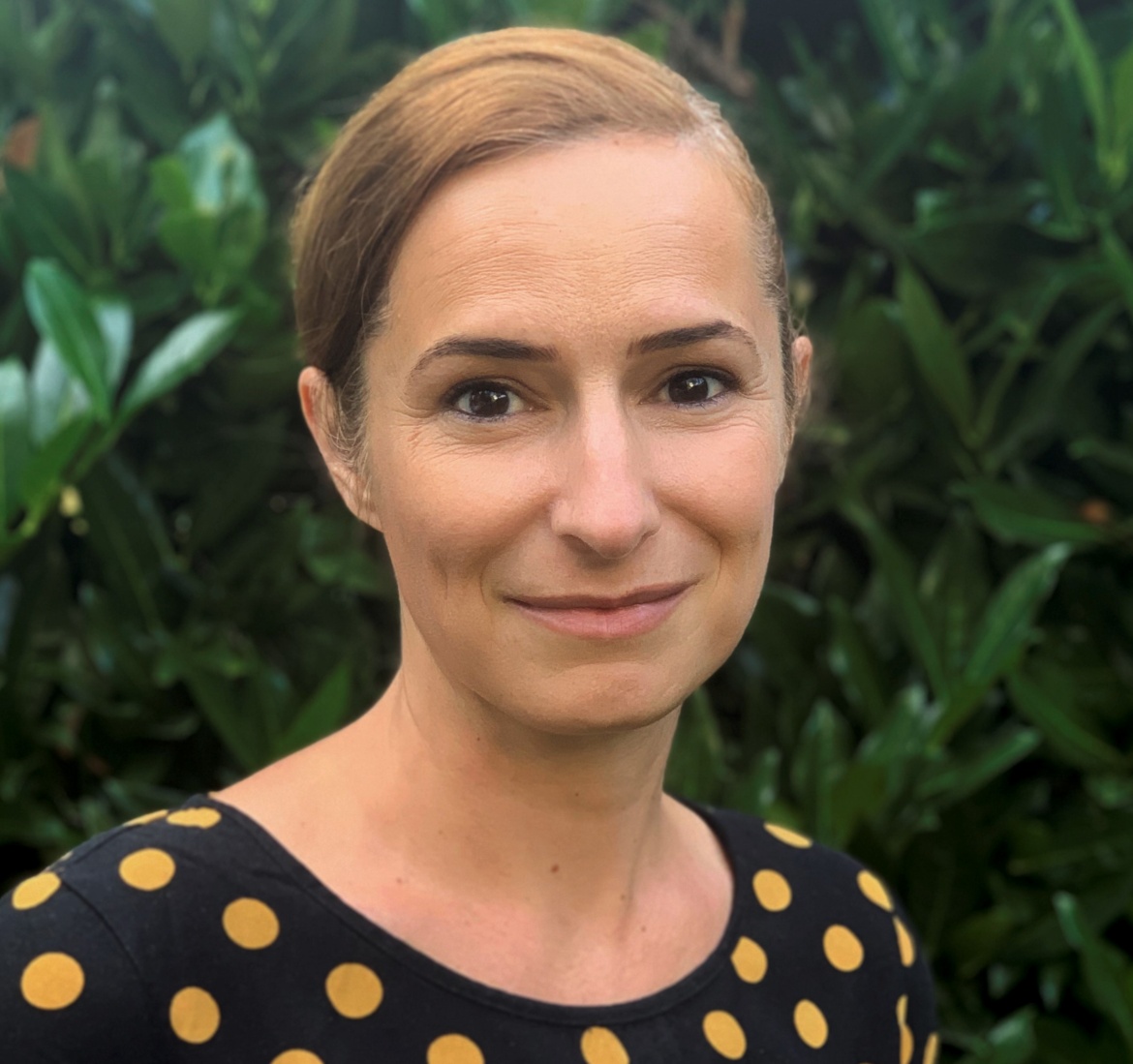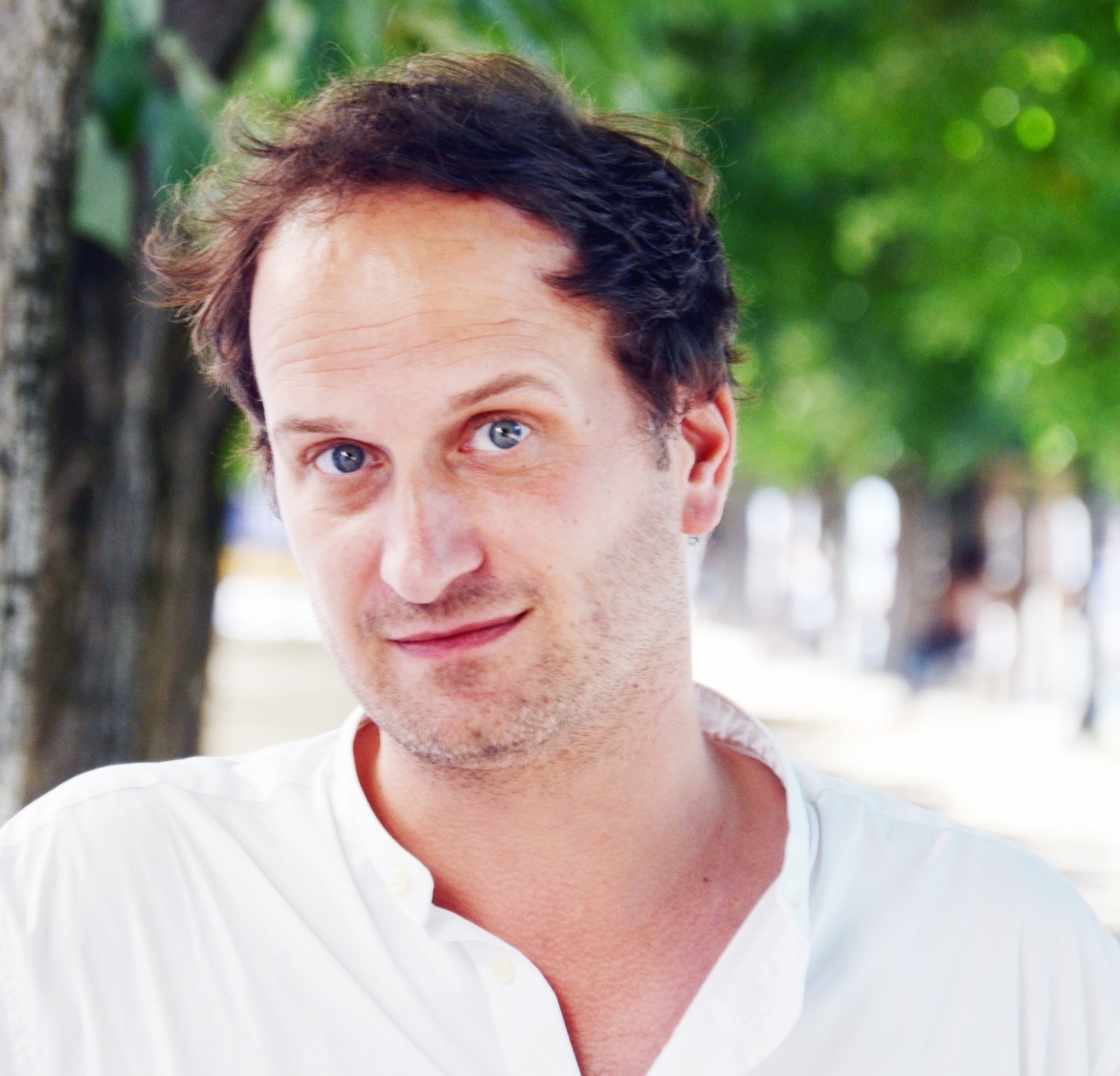Procedure of a Real-World Laboratory
The Real-World Laboratory concept is based on a co-creative exchange of scientific knowledge and practical experience and is aimed at achieving a shared understanding of a given problem in conjunction with collaborative concept development, project processing, and results evaluation. Researchers contribute "their scientific knowledge, their methodological competence, and their, in comparison with the practitioners, hands-off, purely academic ability to reflect and evaluate the project. The real-world participants, in turn, contribute their specific experiential and practical knowledge" (WBGU 2016, 542).
Oriented on the transdisciplinary research process design and the transition management cycle, Real-World Laboratory projects comprise three phases: co-design, co-production, and co-evaluation including multiple feedback and learning loops (Wanner et al. 2018:11 ff.).
Co-Design
Researchers initiate and design Real-World Laboratory projects, and a transdisciplinary team is assembled right at the application phase, which will include researchers and stakeholders with practical experience in the fields of administration, politics, culture, business, and civil society. Because funding programs are primarily aimed at scientific institutions, it is often the scientists who form the core team that manages and assumes responsibility for these processes.
The context description and problem delimitation are followed by a stakeholder analysis. From the outset, Real-World Laboratories pursue collaboration among all relevant, interested, and necessary stakeholders and establish a network throughout the duration of the project (Seebacher, A. et al. 2018). Participants contribute a diverse range of knowledge and pursue different personal as well as institutional goals through their participation. During the discovery phase, it is important to use formats that enable the participants to get to know one another, to structure existing knowledge, and to identify research needs. During the process of joint problem understanding and goal definition, the object domain – a so-called boundary object – is identified (Bergmann et al., 2010:106), which describes and delimits a real-world problem. This makes the problem amenable to research and enables the co-design and co-production of transformational knowledge by both academia and real-world practitioners (cf. Borner, Kraft, 2018; 8ff.). The formulated goals must be binding, specific, and realistic.
The research design development process also includes defining the roles of all participants, although these (may) change over the course of the project. Even in the initial phase, it is essential to define quality criteria and the "rules of the game".
Co-production of knowledge
A system analysis is an integrative way of capturing the knowledge from the scientific disciplines and practical contexts involved that is of relevance to a given topic or field of action. These disparate bodies of knowledge are brought together in the process and discussed in order to arrive at a shared systemic understanding, i.e., an understanding of the fact-based relationships and the current problem nexus. Specific visions and scenarios of desirable futures are then developed on this basis.
Real-world experiments, which are designed in a participatory manner and primarily serve as empirical research methods, are used to test transformation processes. They also serve as demonstration projects for the public: solution proposals for a sustainable future become visible, tangible, comprehensible, and communicable in real-world experiments (cf. Eckart et al. 2018: 113).
"As a municipality, we were able to actively collaborate with our citizens to shape the project at the Schorndorf Real-World Laboratory. Without a doubt, one special feature of the Real-World Laboratories is the active practical testing of scientific assumptions with the critical involvement of practical stakeholders and citizens, which may then be adapted if necessary. This is the only way to remain responsive to local conditions whilst integrating the needs of an urban society into the project."
Co-evaluation
The entire Real-World Laboratory process is evaluated in a collaborative manner whereby interim goals, work package results, individual and institutional learning effects, and findings from ancillary research are also taken into account.
There is a particular focus on the impact of the Real-World Laboratories and on the learning effects from the real-world experiments. The transformation knowledge gained is then documented, communicated, and disseminated in both academic circles and to the general public.
The evaluation and quality assurance of transformative research projects should also include innovative forms of societal impact assessments. "The term 'societal impact' refers to the impact of research beyond academic/scientific achievements, i.e., the long-term changes in society, politics, or businesses" (Stelzer et al. 2018: 405 with reference to Lüderitz et al. 2017).
"The Real-World Laboratories at the University of Stuttgart are innovative research centers in which strong transdisciplinary coalitions are nurtured and in which connections are formed between practical and scientific knowledge. This is the basis for problem solving in an era of increasingly shorter innovation cycles, more rapid change, and complex global challenges. The only way to achieve global objectives, such as the UN Sustainable Development Goals (UN-SDG), is through the co-production of knowledge at the local level and in a social context, for example in real-world urban neighborhoods, whereby Real-World Laboratories have the potential to, or more precisely the task of creating interfaces between academia, policymakers, and society."
All process phases are documented in detail and in a variety of ways, which promotes reflection and shared learning. The documentary methods used include logs and minutes, photographic records, graphic recordings, narrative accounts, and retrospectives that make the complex and iterative Real-World Laboratory processes transparent and comprehensible. Close communication within the project teams (regular meetings, newsletters) and with the general public are important aspects of the work carried out in Real-World Laboratories. This includes public appearances and in-house events, participation in events organized by partners which relate to relevant topics, publications, and presentations at meetings and conferences.
Our toolbox is a compilation of methods that are (or can be) used in different phases of Real-World Laboratory and have been tested in Stuttgart projects. It is not (necessarily) the case that the Real-World Laboratory process steps shown in the table are carried out in a linear fashion; the sequence depends on the specific circumstances and dynamics of the respective projects.
Toolbox [dt.]
|
Arbeitsschritt |
Methoden |
Anwendung und Formate |
|---|---|---|
|
Bildung eines transdisziplinären Projektteams, Klärung der Aufgaben/Arbeitspakete und Rollen |
|
|
|
Gemeinsame Sprache finden, Entwicklung einer Kommunikationsstrategie und Festlegung der Kommunikationskanäle |
|
|
|
Prinzipien der Zusammenarbeit, Festlegung gemeinsamer Regeln, Konzept und Programm der Partizipation |
Kooperationsvereinbarung |
Kooperationsvereinbarungen mit den Kommunen im Rahmen der Teilprojekte (KTP) im Reallabor Stadt-Raum-Bildung (Eckart et al. 2018:112) |
|
Identifikation und Kategorisierung der Akteure (Schlüsselakteure, Stakeholder, „Pioniere des Wandels“, Vetoplayer, Multiplikatoren etc.), Klärung der Ziele und Motivationen |
|
Formate im RNM 1 und Stadt-Raum-Bildung (Seebacher et al. 2018, Eckart et al. 2018:120ff.) |
|
Einladung zur Beteiligung im Reallabor Schorndorf (Gebhardt & König 2021:340 ff.) |
|
|
|
Haushaltsbefragungen |
Bürgereinstellungen zur Energiewende im Energielabor Tübingen |
|
|
|
Mitmachaktion über online-Formular und Online-Befragungen zur Klimaneutralität im Reallabor CampUS hoch i |
|
Projektvorstellung, Kennenlernen und Vertrauensaufbau, Sammeln von Problemen und Handlungsbedarfen, gemeinsame Problemdefinition, thematische und räumliche Eingrenzung, Formulierung der Fragestellungen, Zieldefinition
|
|
Stakeholderworkshop im RNM 1 (Puttrowait et al. 2018: 205ff., Hartmann et al. 2015) |
|
Öffentliche Auftaktveranstaltung des RNM (Bericht)
|
|
|
Teile 1 und 2 der Exchange-Veranstaltungsreihe – Tür-Öffnerin und Weg-Bereiterin im Reallabor Stadt-Raum-Bildung (Beninghaus et al. 2018) |
|
|
|
|
Beobachtung/Analyse des Beteiligungsprozesses Herrenberg Süd, Verwaltungsbefragungen in Herrenberg und Stuttgart im Reallabor Stadt:quartiere 4.0 (Wandel gestalten 2019:19f, 32) |
|
Kooperationen schaffen, Ideen für Interventionen generieren und konkretisieren |
|
|
|
|
|
Ideenschmieden im Reallabor CampUS hoch i: Ideen in 24 Stunden erarbeiten, Elevator-Pitch, Wettbewerb und Prämierung durch die Jury |
|
|
Konzeption der „Wendepunkte“ |
Workshops mit „Energie-Akteuren“ und Quartiersbewohnern im Energielabor Tübingen (Quénéhervé et al. 2017) |
|
Ideen ausarbeiten - in Verknüpfung mit der universitären Lehre und in der Diskussion mit der Öffentlichkeit |
|
|
|
Workshop zur Bestandanalyse und Entwurf-Seminar „Old School – Neues Lernen” mit Ausstellung im Reallabor Stadt-Raum-Bildung |
|
|
Auswahl der Interventionen / Realexperimente anhand festgelegter Auswahlkriterien |
Ideenwettbewerb |
Auswahl der Realexperimente durch die Jury im RNM (Puttrowait et al. 2018: 216ff., Baum et al. 2020a) |
|
Auswahl der Umbauentwürfe durch die Jury im Stadt-Raum-Bildung |
|
Arbeitsschritt |
Methoden |
Anwendung und Formate |
|---|---|---|
|
Co-Produktion von Systemwissen |
||
|
Systemanalyse – Sammeln des Faktenwissens über die Region/Kontext, Alltags- und Ortswissens der Praxisakteure (bzw. Nutzer:innen), Integration und erste Auswertung der Wissensbestände
|
|
|
|
Katalog/Handbuch als offene Sammlung |
(Grün-)Quartett im Reallabor Stadt:quartiere 4.0 (Wandel gestalten 2019:23, 59) |
|
|
1. Phase der TraSy-Methode - Nutzer:innen im alltäglichen Kontext verstehen
|
TraSy-Methode – Methode zur transdisziplinären Entwicklung soziotechnischer Systeme im Reallabor Schorndorf (Gebhardt L. & König A. 2019) |
|
|
|
Rundgänge und Exkursionen |
|
|
Co-Produktion von Zielwissen |
||
|
Entwicklung von Visionen und Szenarien wünschenswerter Zukünfte
|
|
2-teiliger transdisziplinärer Visionsworkshop (Zukunftslabor), Seminar und Ausstellung im RNM 1: Erarbeitung wünschenswerter Zukünfte mit den Bürger:innen, Überführung der Versionen mit Methoden verschiedenen Disziplinen zu Szenarien durch Wissenschaftler:innen, Visualisierung durch Studierende, gemeinsame Reflexion im gegenseitigen Lernprozess (Alcántara et al. 2018; 2018a) |
|
Visionen und Statements für die Zukunft der Städte im Reallabor Stadt:quartiere 4.0 (Wandel gestalten 2019: 23f., 31, 44) |
|
|
Teile 3 und 4 der Exchange-Veranstaltungsreihe – Weg-Begleiterin und Ziel-Erspäherin im Reallabor SRB (Beninghaus et al. 2018) |
|
|
|
2. und 3. Phase der TraSy-Methode: Nutzertypen (Persona), Nutzungsszenarien beschreiben und Ideen, konkrete Konzepte, Prototypen entwickeln
|
Ko-Kreationsworkshops im Reallabor Schorndorf (s. Gebhardt L. & König A. 2019) |
|
Co-Produktion von Transformationswissen |
||
|
Konzeption der Realexperimente – Rahmenbedingungen, Gelingensbedingungen/Erfolgs-und Beschreibungskriterien, Ziele, Veränderungspotentiale/Wirkmechanismen, Methoden der Durchführung, Datenerfassung und -verarbeitung |
Vorträge und Kleingruppendiskussionen |
Transformationsworkshops im RNM 1 und Methodenworkshop im RNM 2 (Lindner et al. 2020) |
|
Durchführung der Realexperimente – Erprobung von Innovation zur Generierung des Erfahrungswissens mit begleitender Datenerhebung
|
Methoden empirischer Sozialforschung:
in Kombination mit stadtsoziologischen Methoden:
|
im RNM 2 (Kuhn et al. 2018; Baum M., Klawiter, S., Noller H. 2020a; Lindner et al. 2020; Lindner, Alle 2020) |
|
4. Phase der TraSy-Methode: Erprobung im Pilotbetrieb
|
9-monatiger Testbetrieb des neu entwickelten Bussystems im Reallabor Schorndorf (Brost et al. 2018; Gebhardt et al. 2019; Reallabor Schorndorf Projektbericht 2019)
|
|
|
Arbeitsschritt |
Methoden |
Anwendung und Formate |
|---|---|---|
|
Festlegung der Bewertungskriterien, Abgleich mit Zielstellungen und Erwartungen, Verstehen der Wirkmechanismen der Realexperimente, Erfassung, Interpretation, Reflexion und Vorstellung der Projektergebnisse mit Blick auf Dissemination und Etablierung |
|
Abschlussberichte der Realexperimente, Reflexionsworkshops, mehrtägige Abschlussveranstaltung mit einer Fachtagung im RNM 1 (Stuttgart in Bewegung 2018; Videoclip) |
|
Teil 5 der Exchange-Veranstaltungsreihe –Ziel-Beschreiterin im Reallabor Stadt-Raum-Bildung (Beninghaus et al. 2018) |
|
|
Evaluation der erhobenen Daten im Testbettrieb, Abschlussveranstaltung und Ausstellung im Rathaus Schorndorf (Brost et al. 2018, Gebhardt et al. 2019, Reallabor Schorndorf Projektbericht 2019) |
|
|
Wissensintegration – Transfer der Ergebnisse in die Wissenschaft und die Praxis |
|
Ergebnisarchiv auf der Webseite des RNM; zum Reallabor Schorfdorf (Gebhardt L. & König A. 2021:) |




